You walk into the garden, wiping sweat from your forehead in the summer’s boggy heat. The peppers are dangling like hidden jewels beneath their glossy leaves. The okra is dazzling with its tropical, hollyhock-like blooms. And the tomatoes are looking fine — even though you flicked a hornworm to your chickens as a treat.
But then you get to the squash patch and pea trellis, and things aren’t so dandy. The leaves look like they got dusted with powdered sugar overnight — and this is no sweet treat. You’ve got a powdery mildew problem on your hands.
What can you do about it? Let’s talk about the proactive and preventative measures that can be taken to banish this fungal destroyer from your garden.
What Is Powdery Mildew?
Powdery mildew is a garden disease caused by a fungus — the Erysiphe genus for those interested. In order to understand the disease, you need to know a bit about the fungus that causes it first. You may remember from seventh-grade life science that plants use chlorophyll to transform the sun’s energy into a usable source of food for themselves. You may also remember that fungi don’t have it so easy. Lacking chlorophyll, they need to find a plant in order to parasitize some energy for themselves.
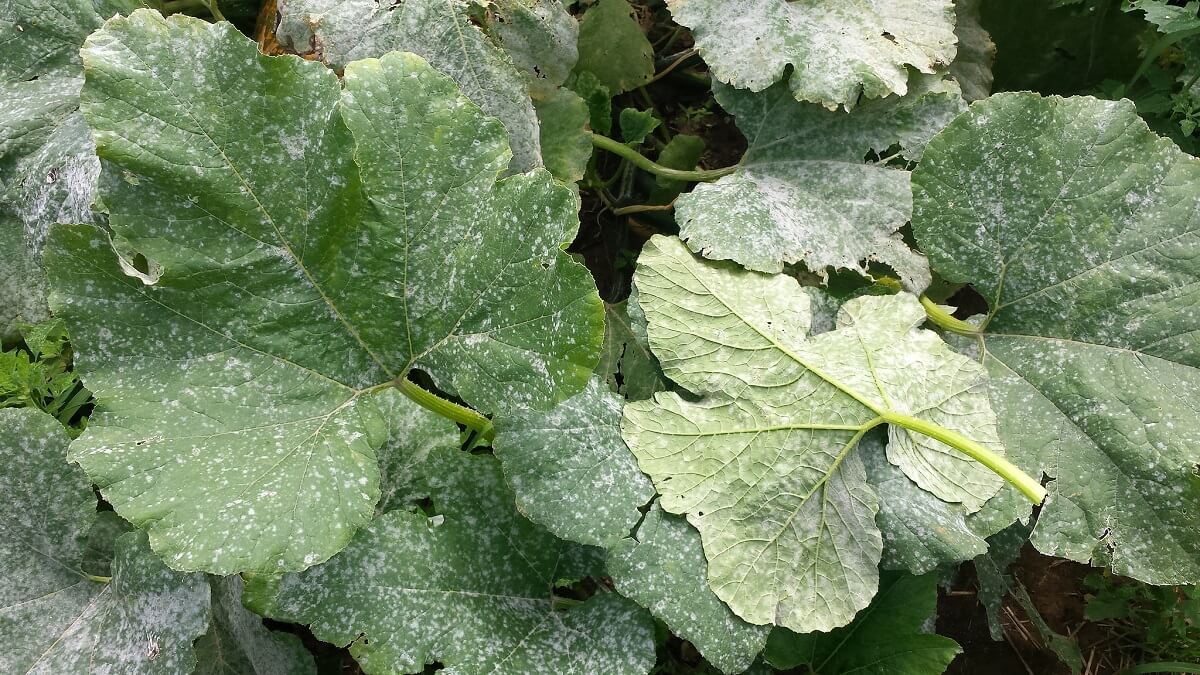
With mushrooms, dead plants are where it’s at (to our composting delight). But with other fungi like the nemesis in this article, living plants are on the menu, and it’s not to their benefit. When wind-borne fungal spores land on a nice, green leaf — from your zucchini, for example — they hang out there until conditions are right.
Then, they germinate into action, tunneling straight into the leaf so their root’s haustoria can feed straight from the living plant. The white stuff you see on the leaf surface is the fruiting body that becomes apparent after several days of feeding.
Related Post: How To Get Rid Of Aphids
It affects almost every garden plant, but particularly plants from the mustard, pea, and gourd families. You can easily identify it by the white or grayish, powdery-looking blotches that gave rise to its name. They’ll start small on the underside, then eventually spread over the entire leaf.
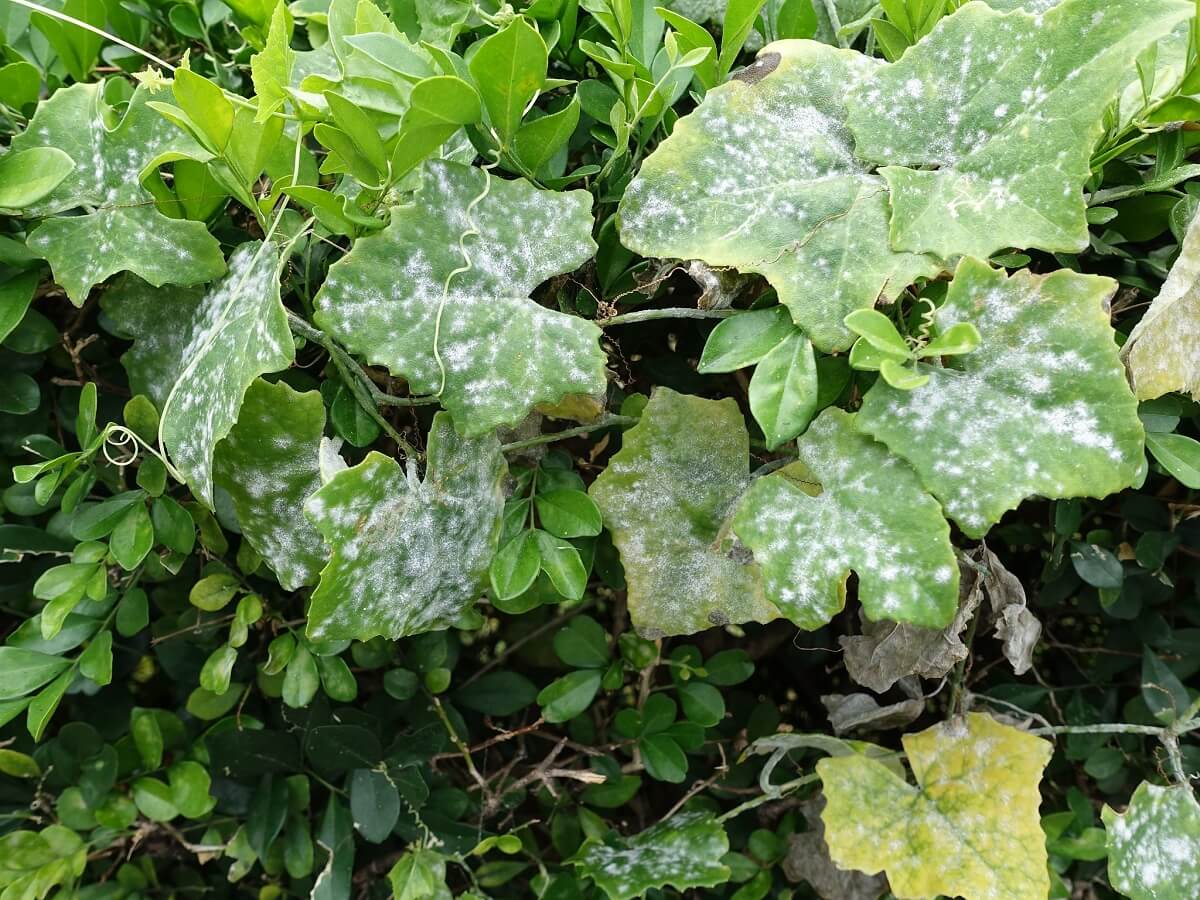
Though it does move slowly, if left unchecked, it will cause affected leaves to turn yellow and brown, and eventually shrivel. Remember, the leaf is basically being sucked dry. It can also attack developing fruit (cucumbers and pea pods are common targets) causing them to develop prematurely and have subpar flavor and texture since their tasty sugars never developed.
Sounds pretty dire, I know — but hang on. There is good news. Fungal diseases aren’t like bacterial or viral infections. In those cases, affected plants need to be uprooted and destroyed to halt the damage. With mildew problems, however, the plants in question can still give you a harvest with some careful management.
How Powdery Mildew Gets In The Garden
As a fungal infection, powdery mildew is spread by airborne spores. That basically means it doesn’t get into your garden. It’s already there, waiting for the right circumstances on the ideal plants — including your roses or lilacs.
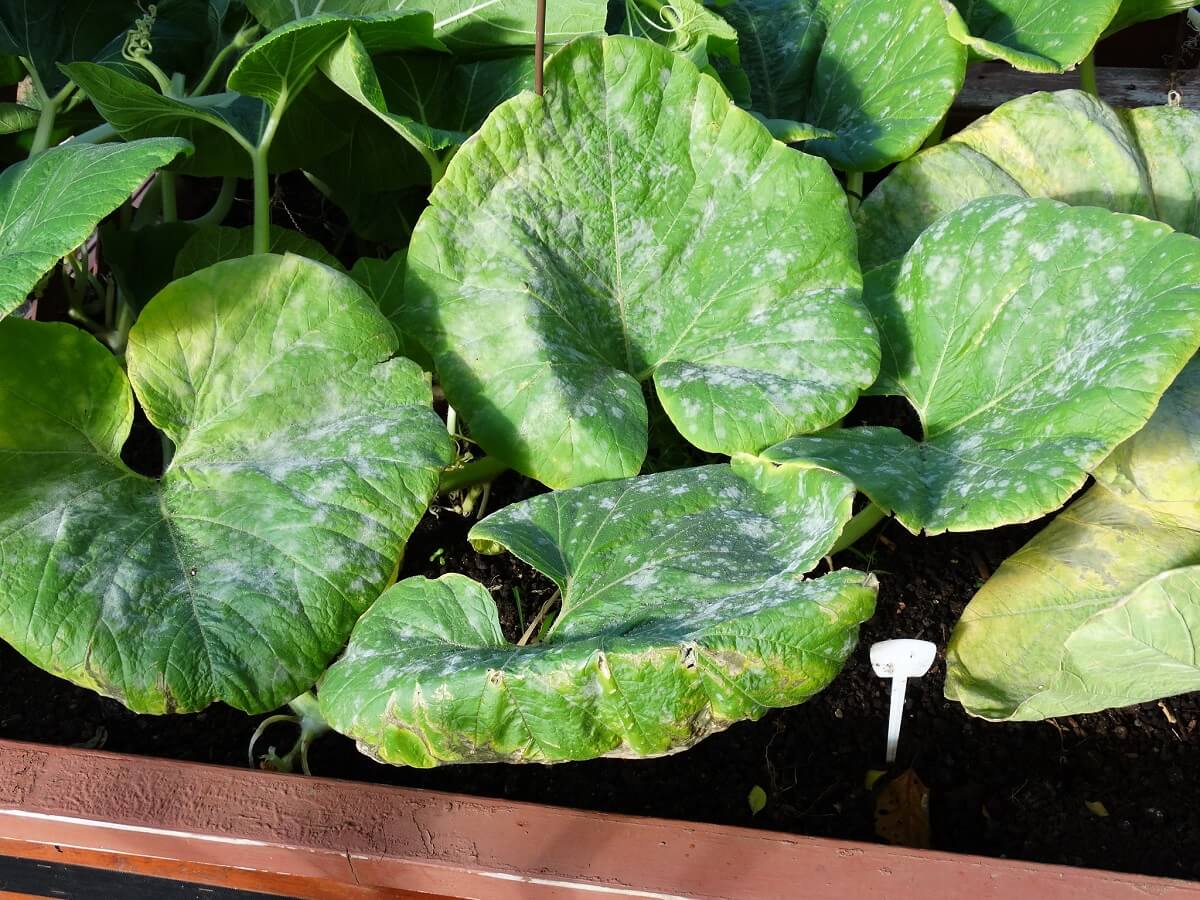
A powdery mildew outbreak is really the result of a perfect combination of conditions. They are so specific, you can probably prepare in advance for it to emerge. As the summer passes its midpoint in your area and begins to cool off, watch for several conditions.
- Daytime temperatures with a high of 65-85 degrees Fahrenheit
- Daytime humidity between 45% and 75% (though it can be present at as low as 20%)
- Night temperatures at around 60 degrees Fahrenheit
- Night humidity around 90%
Check all those boxes, and you can almost guarantee that you will find powdery mildew somewhere in a susceptible garden. Fighting powdery mildew is basically keeping the situation in your garden from reaching the conditions it loves.
How To Get Rid Of Powdery Mildew
If you have a powdery mildew attack, you undoubtedly want it gone, but the reality is that you won’t get powdery mildew out of your garden. Even gardeners in northern areas not known for the disease can be affected by the spores when they are blown from the south on warm summer winds.
Fortunately, even though you can’t beat the unseen spread of the spores, you CAN tilt the scale in your favor by messing up powdery mildew’s favored conditions.
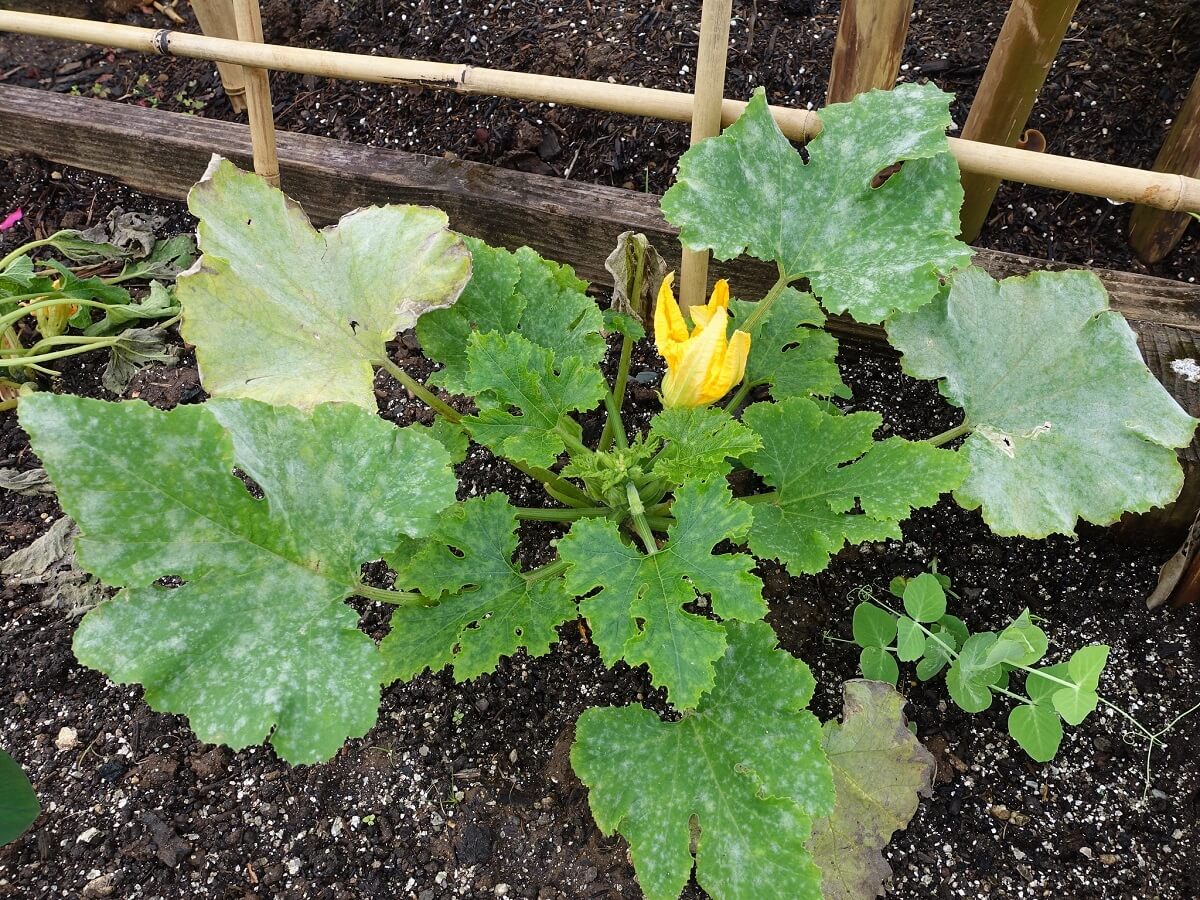
The passive way is to hope that temperatures peak over 85 degrees Fahrenheit again. The disease will halt in its tracks. On the other end of that spectrum, powdery mildew can’t germinate at temperatures lower than 30 degrees Fahrenheit — but by that point, your garden is certainly done growing for the year.
Related Post: Soil Temperature: What It Is And Why It Matters
So let’s say you’re a garden warrior, unwilling to let white fuzziness kill off your cucumbers and garden phlox without a fight. Here are some ideas of what you can do.
Remove The Affected Leaves
Remove leaves covered with the mildew. You don’t want to completely defoliate the poor plant, of course, but removal can help halt the spread. Additionally, some careful pruning of the garden overall may allow for better airflow — damp-loving mildew isn’t a fan of airflow.
Consider Sulfur, But Be Wary
You’ll see quite a bit of garden literature advocating the use of sulfur in powdery mildew combat, but I always feel wary about spraying food plants with something that can be toxic to inhale or ingest. Additionally, sulfur is not a cure-all for plants. There are some it can actually harm such as apple trees or grapes.
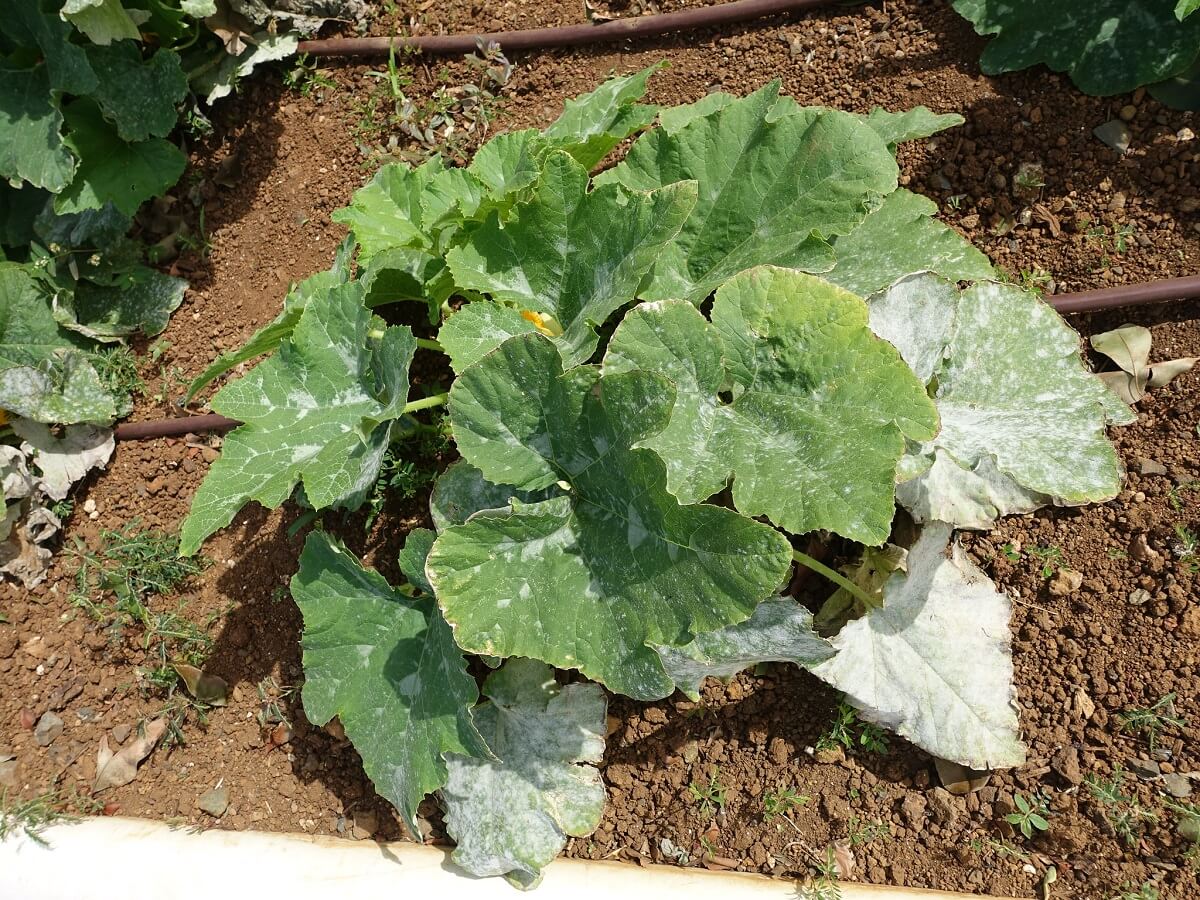
As always when using garden chemicals, read the label carefully, and use them with discernment. If you’re protecting ornamentals like roses or phlox, I can understand, but surely there’s something a little safer to put on your future dinner!
Apply Neem Oil
Thankfully, there is a more natural, organic combatant to fungal outbreaks. Neem oil — an extract from a tree native to India — has been used as both pesticide and fungicide, and it can be used up to the day before harvest. Check out this recipe for a homemade organic spray that can help you stop the spread of powdery mildew.
Finally, as you wage fungal warfare, you can take steps to make your garden positively unhospitable. Enter my next points.
How to Prevent Powdery Mildew In Your Garden
Diseases can be tough to battle in the garden. You can’t tell a plant to take an aspirin and put up its feet until it feels better. The ultimate step to fight powdery mildew is to take away the welcome mat that would allow it to enter in the first place. Good garden practices will keep your garden healthy and strong. Strong enough that disease will have a really hard time finding a foothold.
Consider Your Garden Location
Make sure your garden is in a good location with full sun and good air circulation. A low-lying area in the garden can create a little pocket of moist, damp air and that spells trouble.
Always Do A Fall Cleanup
In the fall, clean up your garden and remove all dead-plant debris. The spores chill out in fallen material through the winter, send them packing to a fall fire or a hot compost pile.
Work To Build Healthy Soil
Take the time to build healthy soil through constant additions of organic matter and green manures. Rich soil makes for strong plants that can resist diseases.
Choose Varieties Suited For Your Climate
Plant the varieties best suited to your specific climate. Growing heirlooms and then saving seeds from the plants you grew in the previous year will help you start developing your own landrace.

This means that successive generations of plants will adapt over time and be naturally better at resisting the specific challenges that your climate offers.
Keep Plant Leaves Dry
Avoid wetting plant leaves whenever possible. It may seem like a good idea to spray the garden when you get home from work, but a late evening shower on your beans means they won’t have time to dry before sundown. Leaves covered with extra water through the cool of the night invite fungus to hang out and take over.
Related Post: 6 Plants That Like Wet Soil
When you need to water the garden, do it in the morning and allow the sunlight to evaporate extra moisture. Additionally, try to water only the soil, and not the whole plant. A drip irrigation hose can be a great tool to use when you need to get moisture to the roots without dousing the foliage.

Try not to work in a soggy garden. You probably don’t think of yourself as a disease vector, but your clothing and tools can handily transport fungus spores that hitchhike in water.
Hopefully, these tips can help you through the next growing season. If you have any additional strategies that won you a powdery mildew victory, drop them in the comments below so we can learn from your experiences.









































If you don’t have Neem Oil on hand and can’t remove any but the most affected leaves, because then your squash wouldn’t have any leaves left, then spraying the less affected leaves with milk (or better yet, sugar-free yoghurt or a similar fermented dairy product diluted with a lot of water) can help as a temporary stop-gap. It won’t completely cure the mildew, but it helps contain its spread until you get around to buy some more effective anti-fungal treatment, or perhaps until you can harvest that last squash at the end of the season. (For me, the mildew always starts on the squash / zucchini in mid to late August, when the plants won’t have more than 3 or 4 weeks to live anyway. Unfortunately, the mildew then moves onto the broccoli and Swiss chard later in the autumn, so it’s still worth the effort to limit the spread before the mildew on the squash plants is ready to release spores.)
The reason this works is the same as how your body (or that of your better half) keeps its constantly moist mucous membranes from developing a yeast / candida infection: microscopic fungii just don’t grow well in an acidic environment, so the body keeps a population of symbiotic bacteria around that produce lactic acid (a very mild organic acid, milder than vinegar). Only if you neutralize that acidic environment (e.g. by washing your nether bits with simple alkaline hand soap, instead of a pH neutral soap-substitute) can fungal microorganisms survive well enough to multiply and irritate the skin. The bacteria that naturally grow in milk (even sterilized milk will quickly get re-infected, if you spray it on an open surface like a leaf) also ferment the lactose sugars in the milk to lactic acid. This process eventually ends up with so much acidity that the proteins in the milk start to curdle, which is how yoghurt is made. (Cottage cheese, Mozzarella and similar white, semi-solid “fresh cheese” products are made differently, with an enzyme used to curdle the proteins instead of acid, so those wouldn’t work as a treatment against fungal diseases.)
What a fabulous tip, Vivi! I’d not heard that one before–and I love the extra explanation you gave as to why it works. For those of us without immediate access to exotic products like Neem–but have our own milk animals–this is wonderful to know. I bet clabbered milk/old raw milk would work really well too, for those a little over-blessed by their cow, haha. I really appreciate the comment, and hope you have a wonderful gardening season!
Wren,
What an excellent article. I would like your permission to share it with the readers of my Dying Time Newsletter–which is about Preparedness and frequently features gardening articles. If I am allowed to use your article I will provide full attribution to you.
I’m one of those gardeners who was told to use sulfur to fight powdery mildew and didn’t know Neem Oil could be used as well, so thank you for that information. I use Neem Oil on my fruit trees so always have it on hand. Vivi’s tip about using milk or yogurt was also news to me–and it shouldn’t have been because I recall my grandmother spraying diluted milk from her Jersey milk cow on her peas. I was a little kid at the time and never thought to ask her why she was doing that.
Please check me out on my author page at http://www.RaymondDeanWhite.com and click on the Prepper Information button to see my archived newsletters. I hope to hear back from you soon.
Thanks so much for the comment and nice words, Ray! We would be happy for you to share the article, especially since you’re thoughtfully remembering to provide attribution. Here’s Insteading’s requests for reposting content: https://insteading.com/copyright/. And would you be able to follow up with a link to the newsletter, if possible? I’d like to see it!
Finally, that’s a neat memory to be able to bank on–so many Grandmas had so much knowledge that’s on the cusp of being forgotten! Thanks for helping keep it alive.
Thanks